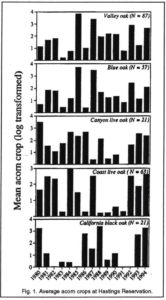Oaks ’n’ Folks – Volume 10, Issue 1 – April 1995
As one of the most abundant natural food resources in California, acorns provide food for a vast array of wildlife from scrub jays to mule deer and were formerly a staple of Native Californians, making up over half the diet of some groups and significantly influencing tribal ranges. Given their importance, it may seem strange that relatively little is known concerning acorn production patterns of California’s oaks. However, the reason is straightforward: sampling acorn production by even a small number of large oak trees can be a daunting proposition; doing so with the prospect of achieving little in the way of results for possibly a decade or more is not a popular route to professional success.
Our work on acorn production began in 1980 at the University of California’s Hastings Reservation in coastal central California. We chose to measure acorn crop size using visual surveys, a method that is quick and, given the number of arboreal acorn predators in California, more accurate than more labor-intensive methods such as acorn traps. We initially marked 250 trees of five species and visit each tree in September at which time we count as many acorns as possible during a 30-second sampling period. With 15 years of data as of fall 1994, we now have enough data to have confidence in the emerging patterns.

As expected, acorn crops at Hastings vary widely in size from year to year (Fig. 1). For example, blue oaks had an average of fewer than one acorn per tree in 1986 and over 60 per tree in both 1985 and 1987. More surprisingly, there was no significant correlation between the acorn crops of the different species with the exception of valley and blue oaks, two closely related species in the same subgenus. In other words, a good year for coast live oaks is not necessarily a good year for any of the other species.
The environmental correlates of the annual differences in acorn crop size differ from species to species. For valley and blue oaks, the most important single factor is weather in April, the peak month for pollination, with crops being heavier in years when mean April temperatures are warmer. This suggests that conditions favoring more efficient pollination are the key to annual variation in acorn production by these species.
For coast and canyon live oaks, mean acorn production is positively correlated with rainfall occurring one and (for canyon live oak) two years earlier. None of the weather factors we tested correlated with the mean annual crop size of California black oak. Interestingly, winter rainfall in the same year as acorn production, the factor most commonly thought to determine crop size, does not correlate positively with mean annual crop size of any of the species we studied.
On top of the large annual variability, individuals of the same species vary drastically in their overall acorn productivity. For example, out of 85 valley oaks for which we have a complete sample of 15 years of data, eleven never produced a very good crop of acorns, while one produced very good acorn crops in 13 of the 15 years! We are currently investigating the factors that contribute to these individual differences. Thus far, we have had some success using soil nutrient availability and, for valley and blue oaks, water availability to the root system of individual trees.
We have recently expanded our work to determine the geographic scale on which acorn crops vary. Thus far, we have sufficient data from three sites located nearly 300 km apart in central coastal California to demonstrate that acorn crops are generally synchronous over at least this large an area. Precisely how far synchrony extends is an intriguing question, and one that we hope to eventually address.
Although the limiting factor in oak regeneration is usually thought to be seedling survivorship rather than acorns, one of the major potential benefits of variable seed production is the increased likelihood of evading seed predators. Consequently, we hope that determining the proximate and ultimate causes of variable seed production will help us not only determine the factors influencing wildlife populations, but also to better understand, and eventually help solve, the regeneration problems of California’s oaks.
Walt Koenig and Jean Knoops
Eftersom erektil dysfunktion är det vanligaste mansproblemet bör det behandlas under medicinsk övervakning. Enligt https://stenhård.net/cialis/ kan du tillsammans med Cailis ta mer än en session för att slutföra en uppsättning övningar för att förbättra ditt tillstånd.
prepared and edited by John M. Harper, Richard B. Standiford, and John W. LeBlanc
